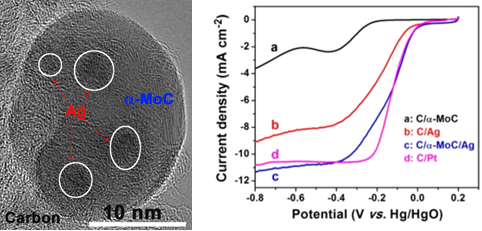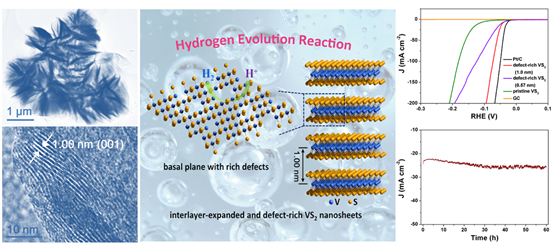Recently,Prof. Zhouguang Lu’s group from the Department of Materials Science and Engineering, SUSTech has published several papers about his researches on energy electrocatalytic materials in leading journals like The Journal of Physical Chemistry Letters (IF:9.353, titled “Synergistic Effects of C/a-MoC and Ag for Efficient Oxygen Reduction Reaction”) and Small (IF:8.643,titled “Synergistic Interlayer and Defect Engineering in VS2 Nanosheets toward Efficient Electrocatalytic Hydrogen Evolution Reaction”).
In recent years, increasing research efforts have been devoted to lithium air batteries due to their exceptionally high theoretical energy density (8135 Wh kg-1 VS ~300 Wh kg-1 for Li ion batteries), good reliability, and low cost. The bottleneck to the commercial application of Li-air batteries is to develop a low cost and high performance electrocatalyst to improve the sluggish kinetics of the oxygen reduction reaction (ORR) and oxygen evolution reaction (OER) at the air electrode. Therefore, it is highly attractive and urgent to explore low cost, feasible, and effective alternatives to noble metals as electrocatalysts for fabricating air electrodes for Li-air batteries. In the JPCL paper, Prof. Lu et al reports a facile method to synthesize cost-effective heterogeneous C/α-MoC/Ag electrocatalysts. Rotating disc electrode (RDE) experiments revealed that the obtained C/α-MoC/Ag exhibited much superior catalytic performance for ORR than that of C/Ag, C/α-MoC, or even the conventional Pt/C. First-principles calculations in collaboration with Prof. Li Huang from the Department of Physics, SUSTech, indicated that the enhanced activity could be attributed to the efficient synergistic effects between Ag and α-MoC/C by which the energy barrier for O2 dissociation has been substantially reduced. Furthermore, Li-air and Al-air cells were assembled to demonstrate the unprecedented electrochemical performance of C/α-MoC/Ag nanocomposites surpassing the Pt/C. Thus, experimental results and theoretical calculations together showed that the heterogeneous C/α-MoC/Ag nanocomposites are promising alternative to platinum for applications in industrial metal-air batteries. This study opens a new perspective for the development of highly active and stable electrocatalysts for the next-generation high energy metal air batteries

Figure 1. (Left) Transmission electron microscope image showing the morphology of the C/ a-MoC/Ag composite electrocatalysts. (Right) Electrocatalytic oxygen reduction performance as a reference to the commercial Pt/C electrocatalyst.

Figure 2. Molecular simulation of the oxygen species adsorbed on Ag4 cluster decorated C/a-MoC (001) surface and the energy profile along the dissociation of O2 reaction coordinate.
In the past three years, Prof. Lu’s group has also theoretically designed and sucdessfully prepared several high performance electrocatalysts for oxygen recuction and evolution reactions based on non-precious coalt elements (Fig. 3), which have attracted great attentions from the community of energy materials.

Figure 3. High performance ORR and OER electrocatalysts based on cobalt for lithium-air batteries.
Hydrogen production from water splitting is generally considered as one of the most promising technique for the wide utilization of hydrogen energy. Active electrocatalysts, such as platinum (Pt) and its alloys, have been known as the state-of-the-art HER catalysts, however, their practical applications are severely hindered by their high cost and scarce natural reserves. Therefore, searching for earth-abundant and non-noble catalysts is of great significance. VS2 is considered as a promising candidate for HER as it is an intrinsic metallic transition-metal dichalcogenide and has a similar layered structure to MoS2. It is a great challenge to finely tune the micro-structure to modify the catalytic properties of VS2. In collaboration with Prof. Jun Xu from the Hefei University of Technology and Prof. Xixiang Zhang from the King Abdullah University of Science and Technology, Saudi Arabia, Prof. Lu et al report a simple one-pot solvothermal method to efficiently enrich the defects of VS2 nanosheets and expand the (001) interlayer spacing to as large as 1.00 nm, which is ~74% expansion as relative to that (0.575 nm) of the pristine counterpart. The interlayer-expanded VS2 nanosheets show extraordinary kinetic metrics for electrocatalytic hydrogen evolution reaction (HER), exhibiting a low overpotential of 43 mV at a geometric current density of 10 mA cm−2, a small Tafel slope of 36 mV per decade and long-term stability of 60 h without any current fading. The performance is much better than that of the pristine VS2 with a normal interlayer spacing, and even comparable to that of the commercial Pt/C electrocatalyst. The outstanding electrocatalytic activity is attributed to the expanded interlayer distance and the generated rich defects. Increased numbers of exposed active sites and modified electronic structures are achieved, resulting in an optimal free energy of hydrogen adsorption (∆GH) from density functional theory (DFT) calculations (Fig. 4). Our work opens up a new door for developing transition-metal dichalcogenides (TMDs) nanosheets as high active HER electrocatalysts by interlayer and defect engineering.

Figure 4. The morphology of layered structured VS2 and the schematic showing the expanded layer structure and HER properties of modified VS2.
Collaborators:
Prof. Li Huang’s group from Department of Physics, SUSTech
Prof. Jun Xu’s group from the Hefei University of Technology
Prof. Xixiang Zhang’s group from the King Abdullah University of Science and Technology
These works were financially supported by the National Natural Science Foundation of China (No. 21671096), the Science and Technology Innovation Commission of Shenzhen (No. JCYJ20170412153139454 and No. JCYJ20150331101823677)and the President Special Funds of SUSTech.
Links:
Cao, LJ, et al. Synergistic Effects of C/α-MoC and Ag for Efficient Oxygen Reduction Reaction. The Journal of Physical Chemistry Letters, 2018, 9, 779-784.
http://dx.doi.org/10.1021/acs.jpclett.7b03347.
Zhang, JJ, et al. Synergistic Interlayer and Defect Engineering in VS2 Nanosheets toward Efficient Electrocatalytic Hydrogen Evolution Reaction. Small, 2018, in press. DOI: 10.1002/smll.201703098.
http://onlinelibrary.wiley.com/doi/10.1002/smll.201703098/full.






